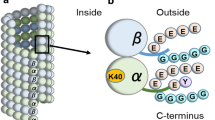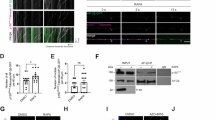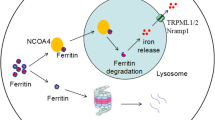Abstract
The interaction of glyceraldehyde 3-phosphate dehydrogenase with microtubules has been studied by measurement of the amount of enzyme which co-assembles with in vitro reconstituted microtubules. The binding of glyceraldehyde 3-phosphate dehydrogenase to microtubules is a saturable process; the maximum binding capacity is about 0.1 mole of enzyme bound per mole of assembled tubulin. Half saturation of microtubule binding sites is obtained at a concentration of glyceraldehyde 3-phosphate dehydrogenase of about 0.5 µM Glyceraldehyde 3-phosphate dehydrogenase (between 0.1 and 2 µM) induces a concentration-dependent increase a) in the turbidity of the microtubule suspension without alteration of the net amount of polymer formed and b) in the amount of microtubule protein polymers after cold microtubule disassembly. There is a linear relationship between the intensity of the glyceraldehyde 3-phosphate dehydrogenase-induced effects and the amount of microtubule-bound enzyme. The specificity of the association of glyceraldehyde 3-phosphate dehydrogenase to microtubules has been documented by copolymerization experiments. Assembly-disassembly cycles of purified microtubules in the presence of a crude liver soluble fraction results in the selective extraction of a protein with an apparent molecular weight of 35 000 identified as the monomer of glyceraldehyde 3-phosphate dehydrogenase by peptide mapping and immunoblotting.
In conclusion, microtubules possess a limited number of binding sites for glyceraldehyde 3-phosphate dehydrogenase. The binding of the glycolytic enzyme to microtubules shows a considerable specificity and is associated with alterations of assembly and disassembly characteristics of microtubules.
Similar content being viewed by others
Abbreviations
- Mes:
-
2(N-morpholinoethane) sulfonic acid
- EGTA:
-
ethylene glycol bis (β-aminoethyl-ester)N,N,N′,N′ tetraacetic acid
- EDTA:
-
thylene diamine tetraacetic acid
References
Borisy GG, Marcum JM, Olmsted JB, Murphy DB, Johnson KA: Purification of tubulin and associated proteins from porcine brain and characterization of microtubule assembly in vitro. Ann NY Acad Sci 253:107–132, 1975.
Huber G, Alaimo-Beuret D, Matus A: MAP3, characterization of a novel microtubule-associated protein. J Cell Biol 100:496–507, 1985.
Parysek LM, Asnes CF, Olmsted JB: MAP4, Occurrence in mouse tissues. J Cell Biol 99:1309–1315, 1984.
Cleveland DW, Hwo SY, Kirschner MW: Purification of tau, a microtubule-associated protein, that induces assembly of microtubules from purified tubulin. J Mol Biol 116:207–225, 1977.
Berkowitz SA, Katajiri J, Binder HK, Williams RC: Separation and characterization of microtubule proteins from calf brain. Biochemistry 16:5610–5616, 1977.
Webb BC: An ATPase activity associated with brain microtubules. Arch Bioch Biophys 198:296–303, 1979.
Murphy DB, Wallis KT, Hiebsch RR: Identity and origin of the ATPase activity associated with neuronal microtubules. 11. Identification of a 50000 dalton polypeptide with AT Pase activity similar to Fl ATPase from mitochondria. J Cell Biol 96:1306–1315, 1983.
Vallee RB, DiBartolomeis MJ, Theurkauf WE: A protein kinase associated with the projection portion of MAP2 (microtubule-associated protein 2). J Cell Biol 90:568–576, 1981.
Burns RG, Islam K: Nucleoside diphosphate kinase associates with rings but not with assembled microtubules. Eur J Biochem 117:515–519, 1981.
Huitorel P, Simon C, Pantaloni D: Nucleoside diphosphate kinase from brain. Purification and effect on microtubule assembly in vitro. Eur J Biochem 144:233–241, 1984.
Larsson H, Wallin M, Edström A: Acid and alkaline phosphatases in a brain tubulin preparation. J Neurochem 32:155–161, 1979.
Vigny A, Huitorel P, Henry JP, Pantaloni D: Interaction of tyrosine hydroxylase with tubulin. Bioch Biophys Res Commun 92:431–439, 1980.
Daleo OR, Piras MM, Piras R: Diglyceride kinase activity of microtubules. Eur J Biochem 68:339–346, 1976.
Rousset B, Wolff J: Lactoperoxidase tubulin interactions. J Biol Chem 255:2514–2523, 1980.
Wolff J, Cook GH: Microtubule-associated adenylate cyclase. Biochim Biophys Acta 844:34–41, 1985.
Kumagai H, Sakai H: A porcine brain protein (35 K protein) which bundles microtubules and its identification as glyceraldehyde 3-phosphate dehydrogenase. J Biochem 93:1259–1269, 1983.
Huitorel P, Pantaloni D: Bundling of microtubules by glyceraldehyde 3-phosphate dehydrogenase and its modulation by ATP. Eur J Biochem 150:265–269, 1985.
Bergmeyer HU: Methods of enzymatic analysis. Verlag Chemie international, Deerfield Beach, Florida, 1974, Vol 1, pp 466.
Bartholmes P, Jaenicke R: Reassociation and reactivation of yeast glyceraldehyde 3-phosphate dehydrogenase after dissociation in the presence of ATP. Eur J Biochem 87:563–567, 1978.
Cleveland DW, Fischer SG, Kirschner MW, Laemmli UR: Peptide mapping by limited proteolysis in sodium dodecyl sulfate and analysis by gel electrophoresis. J Biol Chem 252:1102–1106, 1977.
Towbin H, Staehelin T, Gordon J: Electrophoretic transfer of proteins from polyacrylamide gels to nitrocellulose sheets: procedure and some applications. Proc Natl Acad Sci USA 76:4350–4354, 1979.
Bradford MM: A rapid and sensitive method for the quantitation of microgram quantities of protein utilizing the principle of protein dye binding. Anal Biochem 72:248–254, 1976.
Pirollet F, Job D, Fischer EH, Margolis RL: Purification and characterization of sheep brain cold-stable microtubules. Proc Natl Acad Sci USA 80:1560–1564, 1983.
Clark MG, Lardy HA: Regulation of intermediary carbohydrate metabolism. In: Advances in Enzyme regulation. Weber G (ed) Pergamon Press, 1975, Vol 3, pp 223–266. 25.|Rousset B, Bernier-Valentin F, Mornex R: Biochemical aspects of the tubulin-microtubule system in non-neural cells. In: Hormones and cell regulation. Dumont JE, Nunez J, Schultz G (eds) Elsevier Biomedical Press, 1982, pp 63–85.
Caswell AH, Corbett AM: Interaction of glyceraldehyde 3-phosphate dehydrogenase with isolated microsomal subfractions of skeletal muscle. J Biol Chem 260:6892–6898, 1985.
Gershon ND, Porter KR, Trus BL: The cytoplasmic matrix: its volume and surface area and the diffusion of molecules through it. Proc Natl Acad Sci USA 82:5030–5034, 1985.
Geiger B: Membrane-cytoskeleton interaction. Biochim Biophys Acta 737:305–341, 1983.
Author information
Authors and Affiliations
Rights and permissions
About this article
Cite this article
Durrieu, C., Bernier-Valentin, F. & Rousset, B. Binding of glyceraldehyde 3-phosphate dehydrogenase to microtubules. Mol Cell Biochem 74, 55–65 (1987). https://doi.org/10.1007/BF00221912
Received:
Issue Date:
DOI: https://doi.org/10.1007/BF00221912




